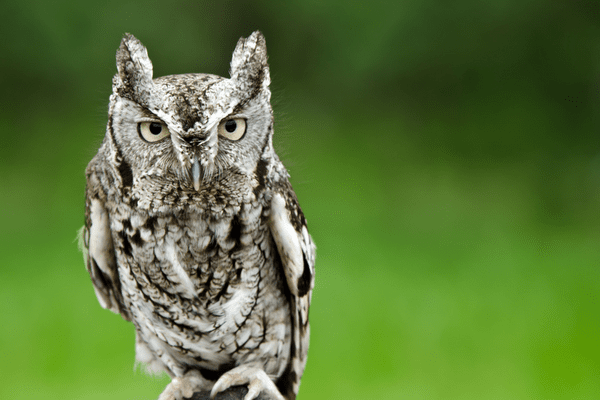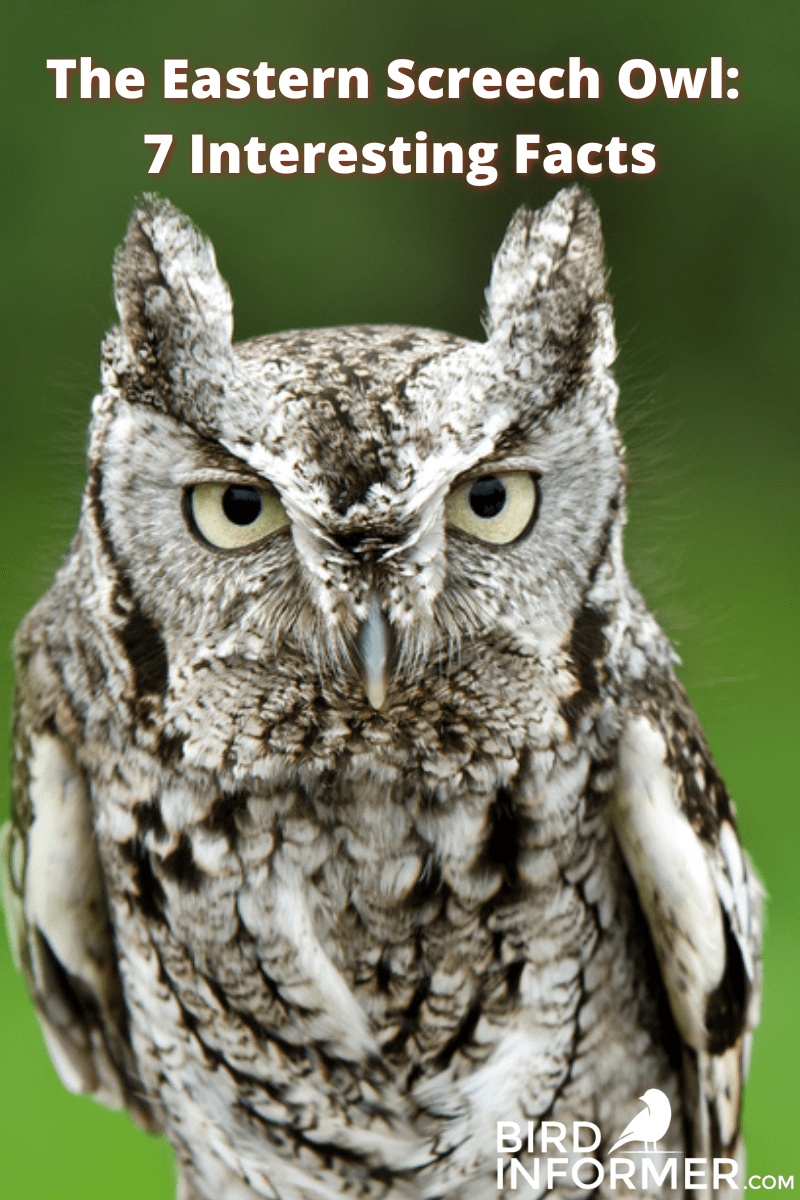Contents
- Eastern screech owl facts
- Eastern screech owl: how-to identify
- Where You’ll See Eastern Screech Owls
- Eastern screech owl diet
- Eastern screech owl nesting
- Eastern screech owl behavior
- How-to attract eastern screech owls
- Eastern screech owl threats
- Eastern screech owl fun & interesting facts
- Eastern screech owl related species in this family
The Eastern screech owl, scientifically known as Megascops asio, is a member of the Strigidae family. This family of owls is known as the true owls. While Eastern screech owl is its only common name, it’s occasionally spelled with a hyphen, making it Eastern screech-owl.
This relatively small common owl can be found throughout North America in the eastern part of the state. It’s found in Canada, Mexico, and everywhere in between. The species prefers wooded environments and it certainly adapts well to man-made developments.
Today, I’d like to discuss some of the more interesting characteristics of the Eastern screech owl and other important facts. The topics I’ll cover will include:
- Eastern screech owl fun and interesting facts
- Ways to identify the Eastern screech owl
- Male and female differences
- Dietary and feeding preferences for Eastern screech owls
- Nesting and behavioral habits
- other important topics
Find out more about the Eastern screech owl by continuing below.
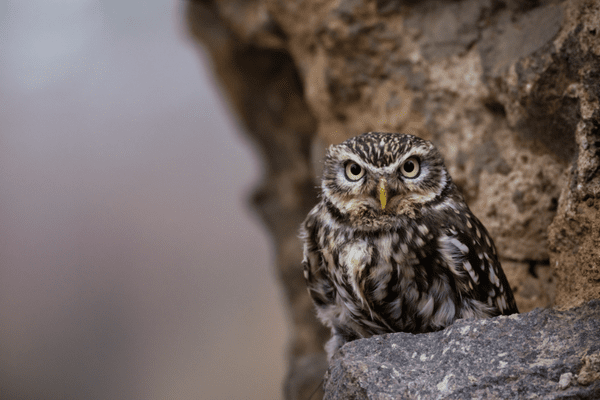
Eastern screech owl facts
- Common Name: Eastern Screech Owl
- Scientific Name: Megascops asio
- Scientific Family: Strigidae
- Life Span: 8-10 years
- Size: 6.5 to 10.0 inches
- Wingspan: 18.0 to 24.0 inches
- Weight: 4.25 to 8.625 ounces
- Conservation status: Least Concern
Eastern screech owl: how-to identify
The Eastern screech owl is a fairly distinctive creature. The bird is short and relatively stocky. It has a large head and its neck is barely visible. It has rounded wings, and its tail is square and short. It also has raised pointed ear tufts, which gives it a very distinct and attractive silhouette.
Related article: 10 Best Live Owl Cams Online: 24/7 Live Streaming
Differences Between Male & Female
The main physical difference between male and female screech owls is the males are smaller than their female counterparts. The males act as hunters for their species, and because they are smaller, it means they can fly and hunt with more agility.
Smaller mail screech owls also possess a different sounding voice than females. The male voice is actually much deeper than the female, which is very noticeable while they are making their hoots and calls.
Differences In Summer Plumage vs Winter Plumage
Eastern screech owls exhibit polymorphisms similar to tawny owls. The colors of their plumage range from gray to rufous.
More specifically, the gray Eastern screech owls are typically found in warmer suburban areas like rural Waco, Texas. The rufous colored Eastern screech owls are typically found in northern latitudes in colder climates.
Where You’ll See Eastern Screech Owls
The Eastern screech owl is a common small owl. It can typically be found in residential areas including parks, backyard nesting boxes, and other well-hidden locations. They are hard to spot and you likely will not know they are even there until they begin making their hunting calls.
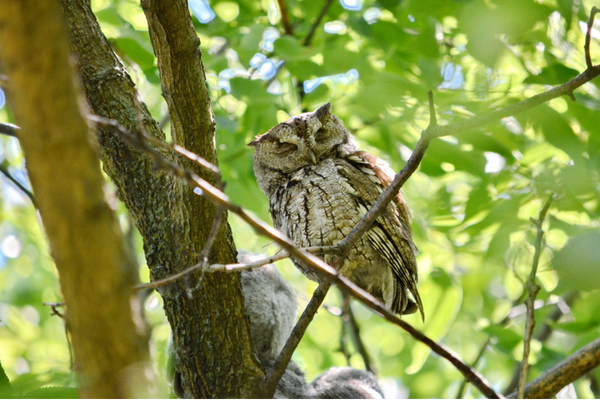
Eastern screech owl bird migration
These nocturnal creatures morph into various colors depending on whether or not they are in a colder climate as opposed to a warmer one. These owls can be found throughout the eastern part of the United States, parts of Mexico, and as far north as Canada.
The nocturnal Eastern screech owls can be found in the Midwest, the southern part of the eastern border in Florida, Texas, Alabama, and everything in between. They also live up near the Great Lakes region, throughout the great state of New York, and you’ll find them as far west as North and South Dakota.
Eastern screech owl diet
The diet of the Eastern screech owl is very broad and has a wide variety of options. These owls are predators just like other members of their species. They eat large insects, crickets, moths, and beetles. They will also catch and devour smaller prey including small birds, bats, shrews, rodents, and mice. They are even known to eat earthworms, spiders, frogs, lizards, crayfish, and other small fish.
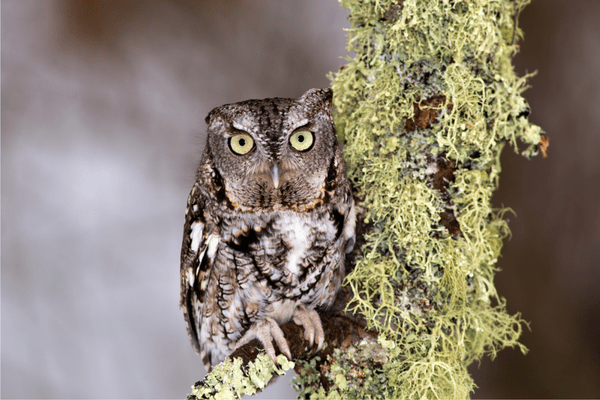
Eastern screech owl nesting
- Clutch Size: 2-6 eggs
- # of Broods: 1 brood
- Incubation Period: 27-34 days
- Nestling Period: 26-30 days
- Egg Description: White
The Eastern screech owl likes to build its nest inside cavities and holes. They never dig these cavities or holes themselves though. They use openings within trees created by squirrels, rot, fungus, or woodpeckers. They are even known to take over abandoned nests left by woodpeckers.
They also are willing to set up their home inside of nesting boxes. They’ll take over nesting boxes both for Purple Martins, Wood Ducks or just about anything else. They are even known to take shelter inside of crates, mailboxes, and wood piles.
Lastly, Eastern screech owls never actually build the nest. Female screech owls lay their eggs on debris resting at the bottom of their nesting cavity. It’s often feathers, droppings, twigs, or wood chips. Basically, she lays her eggs on the prior nest that was left behind by the former resident.
Eastern screech owl behavior
As nocturnal creatures, it makes sense that these creatures are most active at night. Although, they can be found hunting at dusk or dawn at times. And when necessary, they will even hunt in daylight occasionally.
These hunters are very versatile creatures. They wait patiently for prey to pass below them while they wait to pounce in trees. Typically, they remain anywhere from 6-10 feet off the ground before pouncing. Then they’ll swoop down and snatch a bat, insect, tadpole, or fish.
Their flights are typically short. On average, they will only fly for 75 feet before stopping to perch once again. As they travel from perch to perch, they often drop-down, straighten out, and then rise up in a U-shaped pattern.
For the most part, male and female screech owls will form a stable monogamous relationship. Although on occasion, a male screech owl will form a relationship with two females.
The male screech owls are responsible for defending their territory. And during the nesting phase, the female owl will remain inside the nest for the majority of the day. She will come out of her hall very briefly for excursions at dusk or dawn.
This male will feed the female and the hatchlings. But the female is responsible for carrying the prey into tiny bits to make it easier to feed the babies.
Young newly born screech owls have the ability to hunt and fly within 8-10 weeks of being born fledgling.
How-to attract eastern screech owls
It isn’t difficult to attract these owls to your backyard. The best way is to add a nesting box onto the premises. These owls have no problem living in man-made structures, so they will gladly move into your nesting box if one is made available.
A birdbath is another appealing option for the Eastern screech owl. Having a water source to drink from and bathe in within the territory will definitely attract many owls and other birds.
Leaving your lawn relatively long is also attractive to this creature. It gives small prey a place to hide, so rats, mice, voles, and other small insects will hide in the tall grass. This creates easy meals for Eastern screech owls at feeding time.
Does your backyard have gnarled, large, and dense trees? Obviously, this is not something you could add to your backyard very easily. But if you have these trees there already, you can expect these owls to sleep in them during the day and roost in them as they use cavities within these trees as a new nesting place. Okay
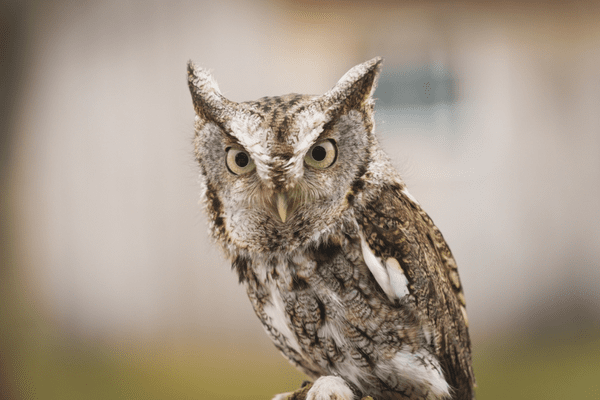
Eastern screech owl threats
The conservation status of this species is considered Least Concern. This means the species still maintains a relatively healthy population. Although, there is a concern for the Eastern screech owl nonetheless. Between 1966 and 2019, the overall population declined by roughly 37%.
Eastern screech owl fun & interesting facts
- This species will bring other animals into their nest. Snakes are one example. They will bring them into their nest to feed on parasitic insects infesting the nest cavity during their pupal and larval stages.
- The necks of Eastern screech owls contain 14 different vertebrae. This is twice as many vertebrae in the necks of human beings. It gives them the ability to turn their head as much as 270° from the original starting point, which is about three-quarters of the way around.
- These owls do not have round eyes. Their eyes are made of a cylindrical shape which gives them the ability to see clearly in the dark. Since they do not have around eyes, screech owls cannot roll their eyes within the sockets.
- They, or any screech owl for that matter, don’t technically screech. It makes a whinny or trilling sound, but not a screech.
- These creatures remain solitary most of the time except during the breeding season. On occasion, you’ll see a pair of screech owls roosting together in a tree or nesting box, but it doesn’t happen too often.
- Other names for Eastern screech owls include Little Horned Owl, Shivering Owl, Mouse Owl, Cat Owl, Little Grey Owl, Texas Screech-Owl, Little-Eared Owl, Desk Owl, Ghosts Owl, and Common Screech Owl.
- Western Screech-Owl
- Northern Saw-Whet Owl
- Northern Hawk Owl
- Great Gray Owl
- Northern Pygmy-Owl
- Elf Owl
- Barred Owl
- Boreal Owl
- Burrowing Owl
- Long-Eared Owl
- Flammulated Owl
- Snowy Owl
- Short-Eared Owl
- Spotted Owl

